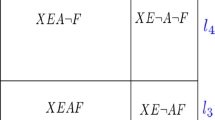Abstract
This paper displays the productive role of the judgment of exchangeability and even conditional exchangeability that should replace the misleading assertion of independence of various experts' opinions regarding uncertain situations. The application is technically rather complicated, and a basic understanding of exchangeability in its simple applications is presumed. One component of the analysis is novel. It suggests how we might specify a likelihood function that allows us to learn about one exchangeable sequence of events from the outcomes of another exchangeable sequence. The substantive content of the the paper concerns the use of personal probabilities by two experts in assessing the sex of human skulls found in anthropological investigations. Although we initially value the two experts' assertions exchangeably, we learn to value one of the expert's assertions more than the other's. Moreover we identify precisely how much to value the elicitation from a second expert after we have already learned the assertion of the first. Valuation is based on a decision theoretic procedure assessing reduction in risk.
Similar content being viewed by others
References
J. Aitchison, The Statistical Analysis of Compositional Data (Chapman and Hall, London, 1986).
S. Cencetti, G. D'Amore, M. Di Bacco and E. Pacciani, Visual diagnosis of the sex of a human skull, and the wagers of de Finetti, in: Atti XI Congresso Degli Antropologi Italiani (1995) pp. 601-608.
P. Diaconis and D. Freedman, De Finetti's generalizations of exchangeability, in: Studies in Inductive Logic and Probability, Vol. 2, ed. R. Jeffrey (University of California Press, Berkeley, CA, 1980).
M. Di Bacco, La diagnosi come regola di decisione (Pittagora, Bologna, 1992).
J. Dickey, Multiple hypergeometric functions: probabilistic interpretations and statistical uses, Journal of the American Statistical Association 78 (1993) 628-637.
C. Genest and J.V. Zidek, Combining probability distributions: a critique and an annotated bibliography, with discussion, Statistical Science 1 (1986) 114-148.
I.J. Good, The Estimation of Probabilities: an Essay on Modern Bayesian Methods (MIT Press, Cambridge, MA, 1965).
F. Lad, Operational Subjective Statistical Methods: a Mathematical, Philosophical, and Historical Introduction (Wiley, New York, 1996).
J.Q. Smith and A.E. Faria, Bayesian Poisson models for the graphical combination of dependent expert information, Journal of the Royal Statistics Society Series B 62 (2000) 525-544.
Author information
Authors and Affiliations
Rights and permissions
About this article
Cite this article
Lad, F., Di Bacco, M. Assessing the Value of a Second Opinion: the Role and Structure of Exchangeability. Annals of Mathematics and Artificial Intelligence 35, 227–252 (2002). https://doi.org/10.1023/A:1014595520497
Issue Date:
DOI: https://doi.org/10.1023/A:1014595520497




